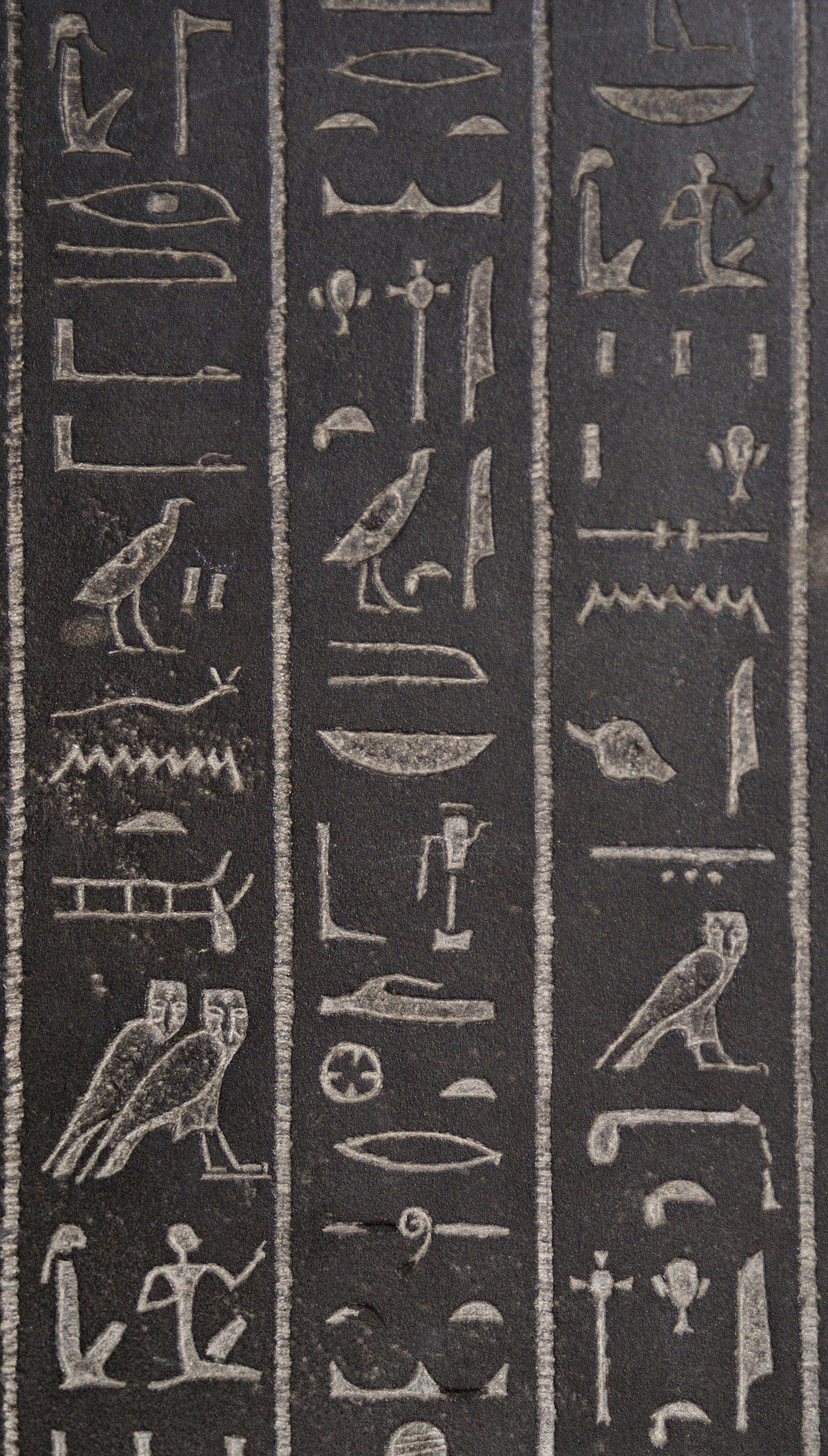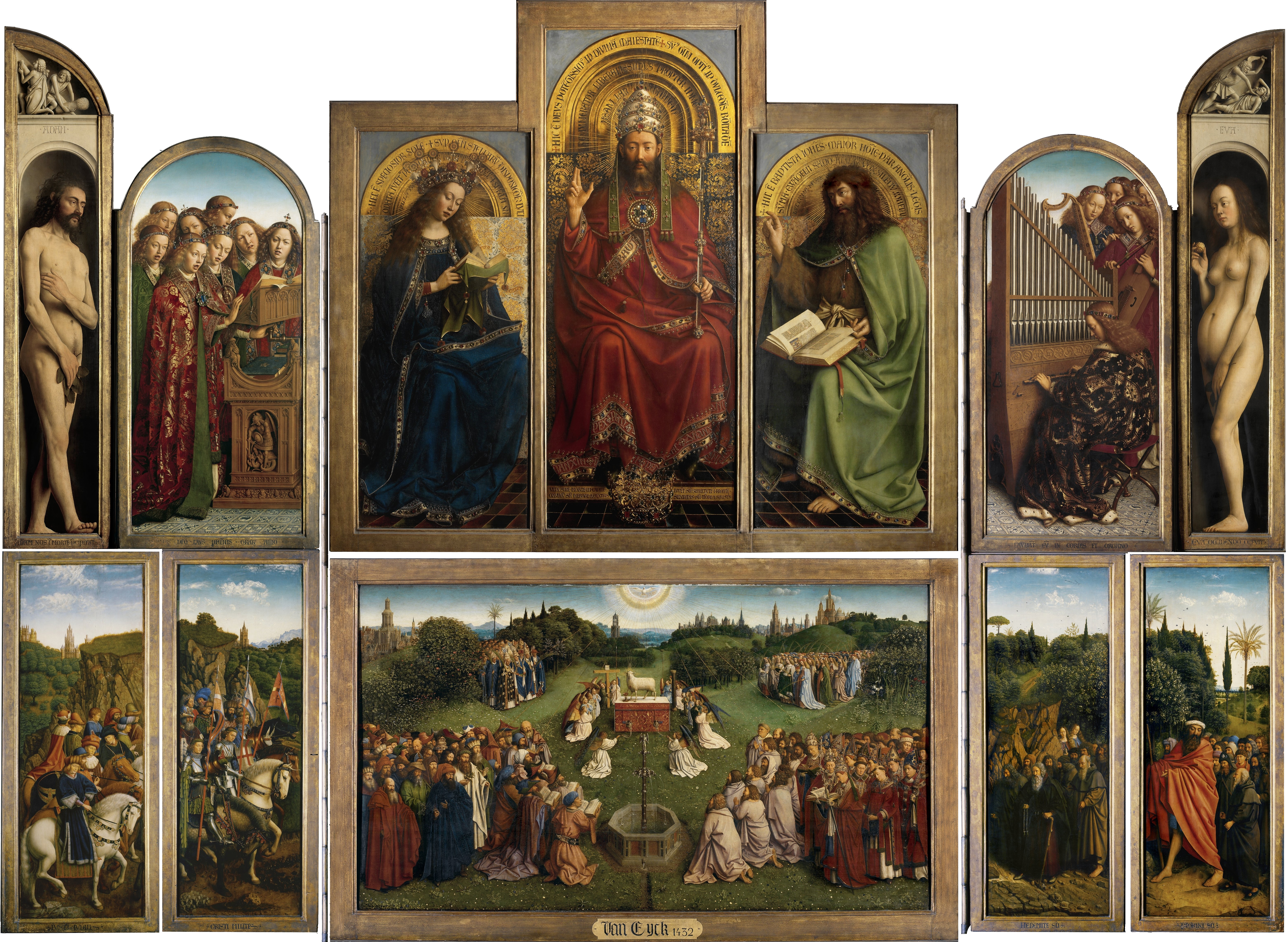|
Quadrat (hieroglyph Block)
A quadrat block (or ''quadrate block'') is a virtual rectangle or Square (geometry), square in Egyptian hieroglyphs, Egyptian hieroglyphic text. The glyphs (hieroglyphs) can be variable in number within the ''virtual block'', though they are often proportioned according to variable standardized rules of scribe, scribal methods. The definition for the block in ''Illustrated Hieroglyphics Handbook'' by Schumann-Antelme and Rossini, is: "A 'quadrate' is a virtual square, which although not drawn, guides the hand of the scribe. Hieroglyphs must be aesthetically positioned within the quadrate and their size must be proportioned accordingly. They form groups that are pleasing to the eye and based on the laws of balance." Rosetta Stone closeup An example of five lines of text from the Rosetta Stone, (lines 9, 10, 11, 12, 13), shows a width of about six to seven virtual blocks. Line 12, (fourth line) is illustrative of the variable size, in this case the widths, of the 'virtual quadrate ... [...More Info...] [...Related Items...] OR: [Wikipedia] [Google] [Baidu] |
Sarcophagus Of Ankhnesneferibre
A sarcophagus (: sarcophagi or sarcophaguses) is a coffin, most commonly carved in stone, and usually displayed above ground, though it may also be buried. The word ''sarcophagus'' comes from the Greek language, Greek wikt:σάρξ, σάρξ ' meaning "flesh", and wikt:φαγεῖν, φαγεῖν ' meaning "to eat"; hence ''sarcophagus'' means "flesh-eating", from the phrase ''lithos sarkophagos'' (wikt:λίθος, λίθος wikt:σαρκοφάγος, σαρκοφάγος), "flesh-eating stone". The word also came to refer to a particular kind of limestone that was thought to rapidly facilitate the corpse decomposition, decomposition of the flesh of corpses contained within it due to the chemical properties of the limestone itself. History of the sarcophagus Sarcophagi were most often designed to remain above ground. The earliest stone sarcophagi were used by Pharaoh, Egyptian pharaohs of the 3rd dynasty, which reigned from about 2686 to 2613 BC. The Hagia Triada sarcoph ... [...More Info...] [...Related Items...] OR: [Wikipedia] [Google] [Baidu] |
Rectangle
In Euclidean geometry, Euclidean plane geometry, a rectangle is a Rectilinear polygon, rectilinear convex polygon or a quadrilateral with four right angles. It can also be defined as: an equiangular quadrilateral, since equiangular means that all of its angles are equal (360°/4 = 90°); or a parallelogram containing a right angle. A rectangle with four sides of equal length is a ''square''. The term "wikt:oblong, oblong" is used to refer to a non-square rectangle. A rectangle with Vertex (geometry), vertices ''ABCD'' would be denoted as . The word rectangle comes from the Latin ''rectangulus'', which is a combination of ''rectus'' (as an adjective, right, proper) and ''angulus'' (angle). A #Crossed rectangles, crossed rectangle is a crossed (self-intersecting) quadrilateral which consists of two opposite sides of a rectangle along with the two diagonals (therefore only two sides are parallel). It is a special case of an antiparallelogram, and its angles are not right angles an ... [...More Info...] [...Related Items...] OR: [Wikipedia] [Google] [Baidu] |
Square (geometry)
In geometry, a square is a regular quadrilateral. It has four straight sides of equal length and four equal angles. Squares are special cases of rectangles, which have four equal angles, and of rhombuses, which have four equal sides. As with all rectangles, a square's angles are right angles (90 degrees, or /2 radians), making adjacent sides perpendicular. The area of a square is the side length multiplied by itself, and so in algebra, multiplying a number by itself is called squaring. Equal squares can tile the plane edge-to-edge in the square tiling. Square tilings are ubiquitous in tiled floors and walls, graph paper, image pixels, and game boards. Square shapes are also often seen in building floor plans, origami paper, food servings, in graphic design and heraldry, and in instant photos and fine art. The formula for the area of a square forms the basis of the calculation of area and motivates the search for methods for squaring the circle by compass and straightedge ... [...More Info...] [...Related Items...] OR: [Wikipedia] [Google] [Baidu] |
Egyptian Hieroglyphs
Ancient Egyptian hieroglyphs ( ) were the formal writing system used in Ancient Egypt for writing the Egyptian language. Hieroglyphs combined Ideogram, ideographic, logographic, syllabic and alphabetic elements, with more than 1,000 distinct characters.In total, there were about 1,000 graphemes in use during the Old Kingdom period; this number decreased to 750–850 during the Middle Kingdom, but rose instead to around 5,000 signs during the Ptolemaic period. Antonio Loprieno, ''Ancient Egyptian: A Linguistic Introduction'' (Cambridge: Cambridge UP, 1995), p. 12. Cursive hieroglyphs were used for Ancient Egyptian literature, religious literature on papyrus and wood. The later hieratic and demotic (Egyptian), demotic Egyptian scripts were derived from hieroglyphic writing, as was the Proto-Sinaitic script that later evolved into the Phoenician alphabet. Egyptian hieroglyphs are the ultimate ancestor of the Phoenician alphabet, the first widely adopted phonetic writing system. Moreov ... [...More Info...] [...Related Items...] OR: [Wikipedia] [Google] [Baidu] |
Scribe
A scribe is a person who serves as a professional copyist, especially one who made copies of manuscripts before the invention of Printing press, automatic printing. The work of scribes can involve copying manuscripts and other texts as well as secretarial and administrative duties such as the taking of dictation and keeping of business, judicial, and historical records for kings, nobility, nobles, temples, and City, cities. The profession of scribe first appears in Mesopotamia. Scribes contributed in fundamental ways to ancient and medieval cultures, including Ancient Egyptian literature, Egypt, Chinese culture#Calligraphy, China, Sanskrit#Writing system, India, Persian literature, Persia, the Roman Empire#Literacy, books, and education, Roman Empire, and Illuminated manuscript, medieval Europe. #Judaism, Judaism, Buddhism, and Islamic manuscripts, Islam have important scribal traditions. Scribes have been essential in these cultures for the preservation of legal codes, religiou ... [...More Info...] [...Related Items...] OR: [Wikipedia] [Google] [Baidu] |
Rosetta Stone
The Rosetta Stone is a stele of granodiorite inscribed with three versions of a Rosetta Stone decree, decree issued in 196 BC during the Ptolemaic dynasty of ancient Egypt, Egypt, on behalf of King Ptolemy V Epiphanes. The top and middle texts are in Egyptian language, Ancient Egyptian using Egyptian hieroglyphs, hieroglyphic and Demotic (Egyptian), Demotic scripts, respectively, while the bottom is in Ancient Greek. The decree has only minor differences across the three versions, making the Rosetta Stone key to decipherment of ancient Egyptian scripts, deciphering the Egyptian scripts. The stone was carved during the Hellenistic period and is believed to have originally been displayed within a temple, possibly at Sais, Egypt, Sais. It was probably moved in late antiquity or during the Mamluk Sultanate (Cairo), Mamluk period, and was eventually used as building material in the construction of Fort Julien near the town of Rashid (Rosetta) in the Nile Delta. It was found there in ... [...More Info...] [...Related Items...] OR: [Wikipedia] [Google] [Baidu] |
N-red Crown (n Hieroglyph)
Deshret () was the Red Crown of Lower Egypt. It was red bowl shaped with a protruding curlicue. When combined with the Hedjet (White Crown) of Upper Egypt, it forms the Pschent (Double Crown), in ancient Egyptian called the ''sekhemti''. The Red Crown in Egyptian language hieroglyphs eventually was used as the vertical letter "n". The original "n" hieroglyph from the Predynastic Period and the Old Kingdom was the sign depicting ripples of water. The word Deshret also referred to the desert Red Land on either side of Kemet (Black Land), the fertile Nile river basin. Significance In mythology, the earth deity Geb, original ruler of Egypt, invested Horus with the rule over Lower Egypt. The Egyptian pharaohs, who saw themselves as successors of Horus, wore the ''deshret'' to symbolize their authority over Lower Egypt. Other deities wore the ''deshret'' too, or were identified with it, such as the protective serpent goddess Wadjet and the creator-goddess of Sais, Neith, who often ... [...More Info...] [...Related Items...] OR: [Wikipedia] [Google] [Baidu] |
N-water Ripple (n Hieroglyph)
The total number of distinct Egyptian hieroglyphs increased over time from several hundred in the Middle Kingdom to several thousand during the Ptolemaic Kingdom. In 1928/1929 Alan Gardiner published an overview of hieroglyphs, Gardiner's sign list, the basic modern standard. It describes 763 signs in 26 categories (A–Z, roughly). Georg Möller compiled more extensive lists, organized by historical epoch (published posthumously in 1927 and 1936). In Unicode, the block ''Egyptian Hieroglyphs'' (2009) includes 1071 signs, organization based on Gardiner's list. As of 2016, there is a proposal by Michael Everson to extend the Unicode standard to comprise Möller's list. Subsets Notable subsets of hieroglyphs: * Determinatives * Uniliteral signs * Biliteral signs * Triliteral signs * Egyptian numerals Letter classification by Gardiner List of hieroglyphs See also *Egyptian hieroglyphs Ancient Egyptian hieroglyphs ( ) were the formal writing system used in Ancie ... [...More Info...] [...Related Items...] OR: [Wikipedia] [Google] [Baidu] |
Amun
Amun was a major ancient Egyptian deity who appears as a member of the Hermopolitan Ogdoad. Amun was attested from the Old Kingdom together with his wife Amunet. His oracle in Siwa Oasis, located in Western Egypt near the Libyan Desert, remained the only oracle of Amun throughout. With the 11th Dynasty ( BC), Amun rose to the position of patron deity of Thebes by replacing Montu. Initially possibly one of eight deities in the Hermapolite creation myth, his worship expanded. After the rebellion of Thebes against the Hyksos and with the rule of Ahmose I (16th century BC), Amun acquired national importance, expressed in his fusion with the Sun god, Ra, as Amun-Ra (alternatively spelled Amon-Ra or Amun-Re). On his own, he was also thought to be the king of the gods. Amun-Ra retained chief importance in the Egyptian pantheon throughout the New Kingdom (with the exception of the " Atenist heresy" under Akhenaten). Amun-Ra in this period (16th–11th centur ... [...More Info...] [...Related Items...] OR: [Wikipedia] [Google] [Baidu] |
Register (sculpture)
In art and archaeology, sculpture and painting, a register is a horizontal level in a work that consists of several levels arranged one above the other, especially where the levels are clearly separated by lines. Modern comic books typically use similar conventions. It is thus comparable to a row, or a line in modern texts. In the study of ancient writing, such as cuneiform and Egyptian hieroglyphs, "register" may be used of vertical compartments like columns containing writing that are arranged side by side and separated by lines, especially in cylinder seals, which often mix text and images. Normally, when dealing with images it only refers to row compartments stacked vertically. The use of registers is common in Ancient Egyptian art, from the Narmer Palette onwards, and in medieval art in large frescos and illuminated manuscripts. Narrative art, especially covering the lives of sacred figures, is often presented as a sequence of small scenes arranged in registers. S ... [...More Info...] [...Related Items...] OR: [Wikipedia] [Google] [Baidu] |
Wick (hieroglyph)
The total number of distinct Egyptian hieroglyphs increased over time from several hundred in the Middle Kingdom of Egypt, Middle Kingdom to several thousand during the Ptolemaic Kingdom. In 1928/1929 Alan Gardiner published an overview of hieroglyphs, Gardiner's sign list, the basic modern standard. It describes 763 signs in 26 categories (A–Z, roughly). Georg Möller compiled more extensive lists, organized by historical epoch (published posthumously in 1927 and 1936). In Unicode, the block Egyptian Hieroglyphs (Unicode block), ''Egyptian Hieroglyphs'' (2009) includes 1071 signs, organization based on Gardiner's list. As of 2016, there is a proposal by Michael Everson to extend the Unicode standard to comprise Möller's list. Subsets Notable subsets of hieroglyphs: * Egyptian_hieroglyphs#Determinatives, Determinatives * Egyptian uniliteral signs, Uniliteral signs * Egyptian biliteral signs, Biliteral signs * Egyptian triliteral signs, Triliteral signs * Egyptian numerals ... [...More Info...] [...Related Items...] OR: [Wikipedia] [Google] [Baidu] |






